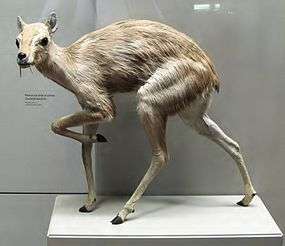Moschidae
| Moschidae Temporal range: Oligocene - Recent | |
|---|---|
 | |
| Restoration of Micromeryx, a typical moschid | |
| Scientific classification | |
| Kingdom: | Animalia |
| Phylum: | Chordata |
| Class: | Mammalia |
| Order: | Artiodactyla |
| Family: | Moscidae Gray, 1821 |
Moschidae is a family of pecoran even-toed ungulates, characterized by long 'saber teeth' instead of horns, antlers or ossicones, modest size (Moschus only reaches 37 pounds in weight, other taxa were even smaller) and a lack of facial glands. Moschus is the only extant genus.[1]
Taxonomy
After Prothero (2007)[2]
Family Moschidae
- Hydropotopsis†
- Hydropotopsis lemanensis
- Hispanomeryx†
- Hispanomeryx aragonensis
- Hispanomeryx daamsi
- Hispanomeryx duriensis
- Hispanomeryx andrewsi
- Oriomeryx†
- Oriomeryx major
- Oriomeryx willii
- Friburgomeryx†
- Friburgomeryx wallenriedensis
- Bedenomeryx†
- Bedenomeryx truyolsi
- Bedenomeryx milloquensis
- Bedenomeryx paulhiacensis
- Subfamily Dremotheriinae†
- Pomelomeryx
- Pomelomeryx boulangeri
- Pomelomeryx gracilis
- Dremotherium
- Dremotherium cetinensis
- Dremotherium guthi
- Dremotherium quercyi
- Dremotherium feignouxi
- Pomelomeryx
- Subfamily Blastomerycinae†
- Pseudoblastomeryx
- Pseudoblastomeryx advena
- Machaeromeryx
- Machaeromeryx tragulus
- Longirostromeryx
- Longirostromeryx clarendonensis
- Longirostromeryx wellsi
- Problastomeryx
- Problastomeryx primus
- Parablastomeryx
- Parablastomeryx floridanus
- Parablastomeryx gregorii
- Blastomeryx
- Blastomeryx gemmifer
- Pseudoblastomeryx
- Subfamily Moschinae
- Micromeryx†
- Micromeryx styriacus
- Micromeryx flourensianus
- Micromeryx? eiselei - this species is a proposed member of genus Micromeryx[3]
- Moschus
- Micromeryx†
References
- ↑ University of Michigan Museum of Zoology - Animal Diversity Web - Moschus (musk deer) Classification http://animaldiversity.ummz.umich.edu/site/accounts/classification/Moschus.html#Moschus
- ↑ Prothero, 2007 (p. 221-226)
- ↑ Manuela Aiglstorfer, Loïc Costeur, Bastien Mennecart, Elmar P. J. Heizmann: Micromeryx? eiselei — A new moschid species from Steinheim am Albuch, Germany, and the first comprehensive description of moschid cranial material from the Miocene of Central Europe, in: PLOS One vom 16. Oktober 2017, DOI: 10.1371/journal.pone.0185679
This article is issued from
Wikipedia.
The text is licensed under Creative Commons - Attribution - Sharealike.
Additional terms may apply for the media files.